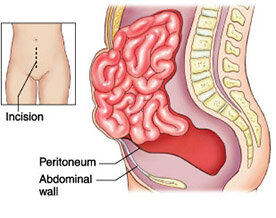
The most common abdominal condition–hernias. Hernias are all too common in both men and women of all ages, but we’re here to diagnose, repair, and get hernia our patients back to good health.
If you’re having any of the following symptoms or complications, it’s time to get checked out by a Carson Surgical Group hernia expert:
A soft lump in the groin, near the navel, or near a surgical scar
Abdominal pain ranging from mild tenderness to severe pain
Nausea and vomiting
TYPES OF HERNIAS
Incisional Hernia
An incisional hernia happens when a weakness in the muscle of the abdomen allows the tissues of the abdomen to protrude through the muscle. The hernia is caused by a weakness in the muscle by an incision made in a prior abdominal surgery. Incisional hernias may be repaired using sutures or tension-free repairs using mesh.
Indirect Inguinal Hernias
An indirect inguinal hernia forms at the inside opening of the inguinal canal, an area that is naturally prone to weakness. With time and the effects of gravity, the intestine can press into the canal and form a bulge in the groin. Indirect inguinal hernias may be repaired using sutures or tension-free repairs using mesh.
Direct Inguinal Hernias
Direct inguinal hernias are similar to indirect inguinal hernias, but less common. They form at a weakness in the abdominal wall next to the opening of the inguinal canal. Over time the intestine can press through the weak area and bulge into the groin. Just like indirect inguinal hernias, direct inguinal hernias may be repaired using sutures or tension-free repairs using mesh.
Umbilical Hernias
An umbilical hernia occurs when part of the bowel or fatty tissue pokes through an area near the belly button, pushing through a weak spot in the abdominal wall. While a developing fetus is in the womb, the umbilical cord passes through an opening in the abdominal wall, which should close before the baby is born. Sometimes, the muscles don’t completely seal, leaving a weak spot, and the hernia looks like a lump in the navel. The majority of the time, an infant’s umbilical hernia closes on its own by the age of 12 months. If the hernia is still there by the time the child is 4 years old, surgery may be recommended.
Umbilical hernias may also develop in adults, most commonly in patients that are overweight, lifting heavy objects, or have a persistent cough. Women who have had multiple pregnancies also have a higher risk of developing an umbilical hernia.
Umbilical inguinal hernias can be repaired using tension-free repairs using mesh.
Femoral Hernias
Femoral hernias are caused by a protrusion of a viscus through a weakness in the containing wall. These types of hernias occur just below the inguinal ligament, when abdominal contents pass through a naturally occuring weakness called the femoral canal. Femoral hernias are much more common in women than they are in men, due to the wider bone structure of the female pelvis. Femoral hernias may be repaired using sutures or tension-free repairs using mesh.
Tension-Free Laparoscopic Hernia Repair
Minimally-invasive, tension-free laparoscopic hernia repairs are what our Carson Surgical Group Abdomen department specializes in. Laparoscopic surgery offers many benefits over open surgery. There is less pain, a faster recovery, and tiny scars instead of a long scar, and because laparoscopic surgery usually takes only 1 to 2 hours, you can likely go home the same day.
The Procedure
During a hernia procedure, you will be given general anesthesia which will keep you free of pain during surgery. Depending on the type of surgery, the number of incisions and placement will vary.
Carbon dioxide gas is injected into your abdomen through an incision near your navel. The gas inflates your abdomen, allowing the surgeon to work efficiently.
After the hernia is repaired, your surgeon will place a strong mesh made of strong, flexible plastic that stays in the body directly over the weak spot in your abdominal wall. The mesh acts just as a patch would on a tire wall, making the recovery faster and less painful. Over time, nearby tissues grow into the mesh to strengthen the repair.






